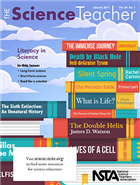Career of the Month: Television Writer
By sstuckey
Posted on 2017-01-30
“I aspire to translate complicated ideas in science into consumable  stories,” says Katherine Lingenfelter, who writes for TV shows with science or science fiction themes, such as House and Westworld, respectively. “Television is a writer’s medium.” Writers research, develop, and pitch ideas for shows, then assemble and oversee teams of other writers to create the scripts. Writers may also have a final say on casting and set design.
stories,” says Katherine Lingenfelter, who writes for TV shows with science or science fiction themes, such as House and Westworld, respectively. “Television is a writer’s medium.” Writers research, develop, and pitch ideas for shows, then assemble and oversee teams of other writers to create the scripts. Writers may also have a final say on casting and set design.
Work overview.
Typically, once filming starts, four episodes are in progress at once: one being “broken” (ideas being developed), one being written, one being filmed, and one being video edited. Each will require your attention. The writers may gather in the writers’ room in the morning. In the afternoons, I go to production meetings, where I might discuss things such as wardrobe, go out on a location scout, or get feedback from network executives on a script draft. I might also go into the editing room to make adjustments. I spend the evening writing.
At the major networks, you work 10.5 months and then get a five-week

Writer Katherine Lingenfelter poses on location for the popular Westworld TV series (for mature audiences) in Fossil Point, Utah. Photo by Matt Belanger.
hiatus. If the show continues, and you’re asked back, you start up again. If not, you look for your next contract. Cable schedules are more varied.
I just finished working as a co-executive producer for HBO’s Westworld, which is about artificial intelligence. I researched topics such as consciousness, biology, and early evolution.
I recently sold a sci-fi pilot idea to the AMC network about a western taking place after climate change. Science fiction writers have the freedom to imagine scientific possibilities, but we also consult with the Science and Entertainment Exchange, a program of the National Academy of Sciences that connects us with scientists and engineers who vet our ideas. I’m also preparing to sell another idea, about cryptozoology, with an environmental bent. A tiny percentage of pitched shows make it all the way to airing on a network.
It’s thrilling to be on set, when 60 people are all focused on one goal,
and everyone plays their part. I also love the research. My least favorite part is the actual writing, which is a lonely endeavor, and I also don’t like it when a project fails.
Career highlights.
Our work can affect real people. A House episode I worked on accurately portrayed cardiopulmonary resuscitation (CPR) and may have inspired people to learn the technique.
Career path.
I wanted to follow in my anesthesiologist father’s footsteps and become a neurosurgeon, but I also adopted my older brother’s love of science fiction. In college, I started out in pre-medicine but switched to psychology. I joined my brother in Los Angeles to try to get into the entertainment industry. After working as an assistant, learning what I needed to know about the industry to become a writer, I eventually landed my first writing job.
Knowledge, skills, and training needed.
Writing competency is important, but a good TV writer needs the imagination to explore ideas and maintain unusual interests. Networks want diverse writers. Writers with varied life experiences are in high demand. Your characters will be more realistic if you’ve observed the world for a while.
Advice for students.
Write a lot about many different things. If you decide to become a TV writer, don’t let go until you do it. Move to Los Angeles or New York or at least submit your work every month. It may take years. Work for people you admire. Almost all my job offers have been based on relationships I developed, so be generous with your ideas and be someone other people like to work with.
Bonus Points
Lingenfelter’s education:
BA in psychology, University of Michigan
On the web:
www.johnaugust.com, www.imdb.com
Related occupations:
screenwriter, science writer, novelist, prop maker, production designer
Editor’s Note
This article was originally published in the January 2017 issue of The  Science Teacher journal from the National Science Teachers Association (NSTA).
Science Teacher journal from the National Science Teachers Association (NSTA).
Get Involved With NSTA!
Join NSTA today and receive The Science Teacher,
the peer-reviewed journal just for high school teachers; to write for the journal, see our Author Guidelines, Call for Papers, and annotated sample manuscript; connect on the high school level science teaching list (members can sign up on the list server); or consider joining your peers at future NSTA conferences.
Disclaimer: The views expressed in this blog post are those of the author(s) and do not necessarily reflect the official position of the National Science Teaching Association (NSTA).



